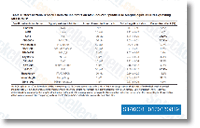Other transcripts predicted to encode enzymes accountable for processing minor polysaccharides current in hemicellulose incorporated B mannosidase, lactase, B thioglucosidase, and B fucosidase. Additional, A. glabri pennis actively expressed transcripts concerned in processing and utilizing mannose and galactose sugars through glycolysis, suggesting that these sugars can be straight utilized for en ergy production. Transcripts predicted to encode cellulases and callases Like many other wood feeding insects, A. glabripennis also generates numerous transcripts predicted to encode cellulases. Among the most striking discoveries these unigenes could encode enzymes with somewhat distinct catalytic abilities that act on diverse cellulose macro molecule substructures, target soluble or insoluble fractions of cellulose, or approach cello oligomers into cellobiose.
Also to GH 5 cellulases, A. glabripennis also expresses endo B 1,four gluca nases classified to GH households 45 and 48. A. glabripennis also developed a sizable amount of B glucosidases, which hydrolyze cellobiose to release glucose. Nearly all these have been classified to GH family members 1, which was quite possibly the most abundant GH family detected from the A. glabripennis mid gut transcriptome. The selleck chemical overabundance of B glucosidases relative to cellulases is frequent in many wood feeding insects and wood degrading microorganisms and is hypoth esized to serve as being a mechanism to indirectly improve cellu lase activity. These B glucosidases can normally act quickly and effectively to release glucose from cellobiose, decreasing the affect of end item inhibition on cellulase action.
Additionally to transcripts encoding enzymes predicted to disrupt big hardwood polysaccharides, selleckchem aurora inhibitors a number of transcripts concerned in degrading small polysaccharides had been detected. For instance, callose can be a linear polysaccharide comprised of B 1,3 and B one,six linked glucose. Though callose is typically associated together with the fleshy and metabolically energetic areas of plants, such as leaves and stems, it really is also sporadically deposited in cell walls of secondary development and repre sents suitable stores of glucose that could be liberated and assimilated by A. glabripennis. Many B 1,3 and B 1,six glucanases detected  while in the midgut transcriptome can be involved in liberating glucose from this polysaccharide. Transcripts predicted to encode enzymes that contribute to lignin and phenylpropanoid degradation Though lignin is extremely abundant during the heartwood of deciduous trees where the A. glabripennis larvae were collected for this research, no transcripts predicted to encode enzymes which have been capable of yielding the styles of lignin degradation products previously observed inside a.
while in the midgut transcriptome can be involved in liberating glucose from this polysaccharide. Transcripts predicted to encode enzymes that contribute to lignin and phenylpropanoid degradation Though lignin is extremely abundant during the heartwood of deciduous trees where the A. glabripennis larvae were collected for this research, no transcripts predicted to encode enzymes which have been capable of yielding the styles of lignin degradation products previously observed inside a.
CETP Signal
CETP is a member of a class of drugs
